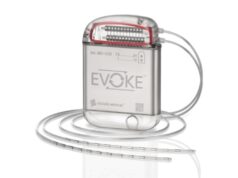 A pilot study published in Neuromodulation: Technology at the Neural Interface suggests that high frequency stimulation (HFS), an alternative SCS waveform could also be effective way of alleviating pain.
A pilot study published in Neuromodulation: Technology at the Neural Interface suggests that high frequency stimulation (HFS), an alternative SCS waveform could also be effective way of alleviating pain.
The purpose of the pilot study was to evaluate efficacy of alternating conventional stimulation and HFS (termed “shuffle” stimulation) in improving SCS outcomes. The shuffle stimulation was designed to deliver conventional stimulation while the patients were in the upright positions, while relative HFS was delivered in lying positions. This was automated through accelerometer technology.
High frequency stimulation (HFS) at 10,000 Hz has been shown to lead to improved pain outcomes compared to conventional SCS in patients with chronic axial back pain and using frequencies higher than conventional stimulation decrease the paresthesias patients experience.1,2 The median HFS used in this study was much lower (240 Hz) but did decrease paresthesias.
The study was designed as a cross-over study in which patients were implanted with an SCS device with an integrated accelerometer. The patients’ implants were programmed on the day after implantation to conventional stimulation, and remained on conventional stimulation for four weeks. At four weeks, patients were randomised to either shuffle stimulation or conventional stimulation and maintained on that stimulation setting for four weeks. Patients then returned results at the eight-week time point and underwent a one-week washout period with conventional stimulation. At this point patients were programmed with the stimulation setting not previously used (either shuffle or conventional) for four weeks until the 13-week time point.
Seventeen participants were enrolled in this study with 12 reaching completion and one patient underwent removal. Participants had a mean age of 52.76±14.6 years and four males and eight females were enrolled. Out of those enrolled, six had a diagnosis of neuropathic pain, four had failed back surgery syndrome and two patients had complex regional pain syndrome (CRPS). The patients were implanted with thoracic SCS leads, eleven patients were implanted with paddle leads and one patient was implanted with percutaneous leads. In study period one, six patients were randomised to receive conventional stimulation and six patients were randomised to receive shuffle stimulation. The study reported no difference in outcomes based on which therapy the participants were exposed to in the first block.
The majority of patients in both the conventional and shuffle stimulation arm had active contacts from the top of T7 to the T9-10 interspace. However, when programming for optimal efficacy and patient satisfaction, contact changes from conventional stimulation were needed in 50% of patients in shuffle arm. During sensory testing, 33% of subjects detected vibration at baseline, 66% detected it after conventional stimulation while 17% detected it with shuffle stimulation. All testing was done while sitting (i.e. with patient on conventional stimulation) thus the change appears to be the result of chronic shuffle stimulation.
When comparing shuffle and conventional results the numerical rating scale (NRS) for pain, current pain scores were improved in shuffle stimulation (4.0±61.6 shuffle to 5.8±2.3 conventional) (p=0.024). Average pain over last week trended toward improvement in shuffle patients, but was not significant (p=0.096).
Julie Pilitsis, lead author of this paper, stated, “It is exciting to see how patients responded in terms of pain relief and sensory testing to alternating waveforms. We need to gain further understanding on which contacts should be used for different stimulation paradigms, but this is a start.”
Overall, the study reported that shuffle stimulation improved NRS current pain scores compared to conventional stimulation, with seven of 11 patients preferring shuffle stimulation.
1Tiede J, Brown L, Gekht G, Vallejo R, Yearwood T, Morgan D. Novel spinal cord stimulation parameters in patients with predominant back pain. Neuromodulation 2013;16:370–375.
2 Kapural L, Yu C, Doust MW et al. Novel 10-kHz high-frequency therapy (HF10 therapy) is superior to traditional low-frequency spinal cord stimulation for the treatment of chronic back and leg pain: the SENZA-RCT Randomized Controlled Trial. Anesthesiology 2015;123:851–860.









